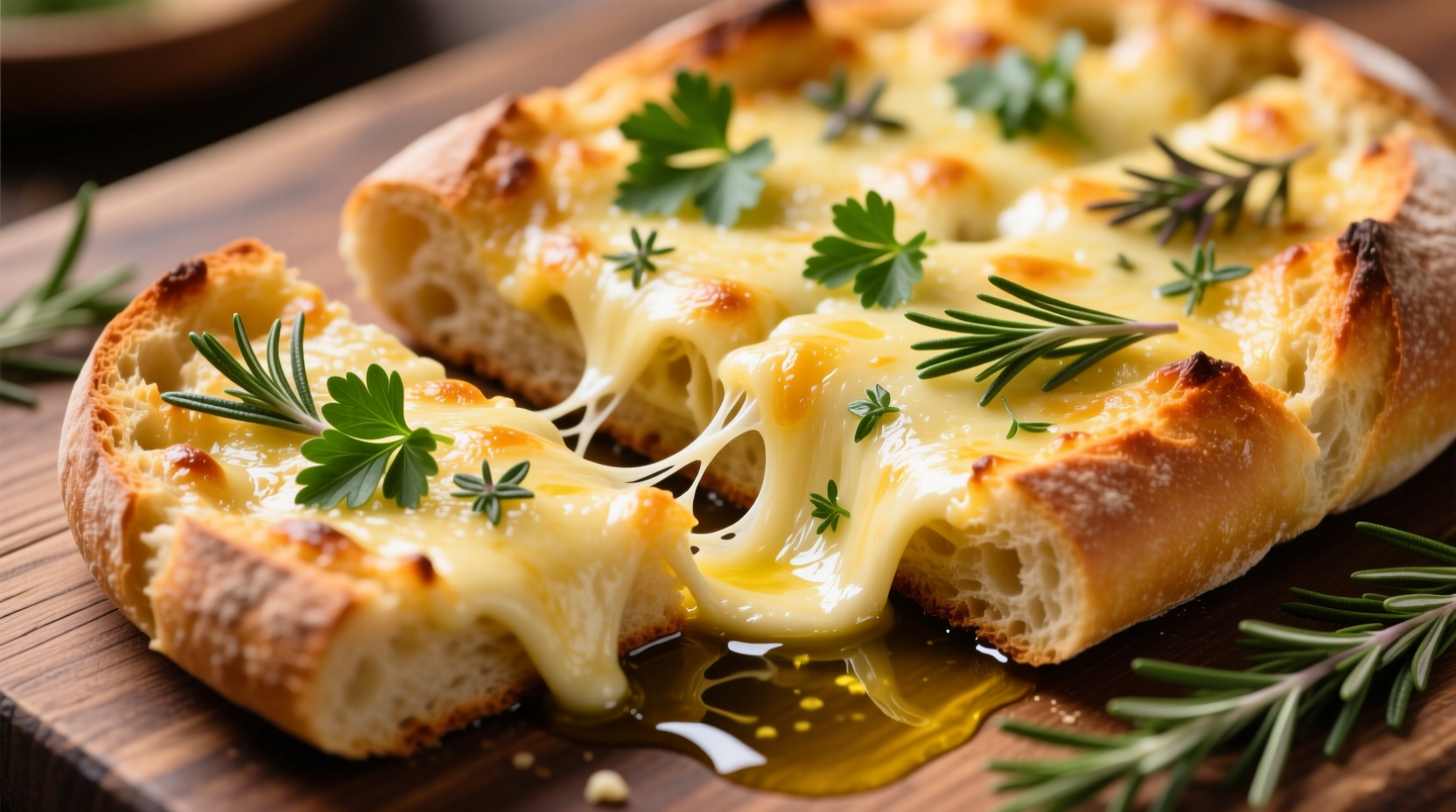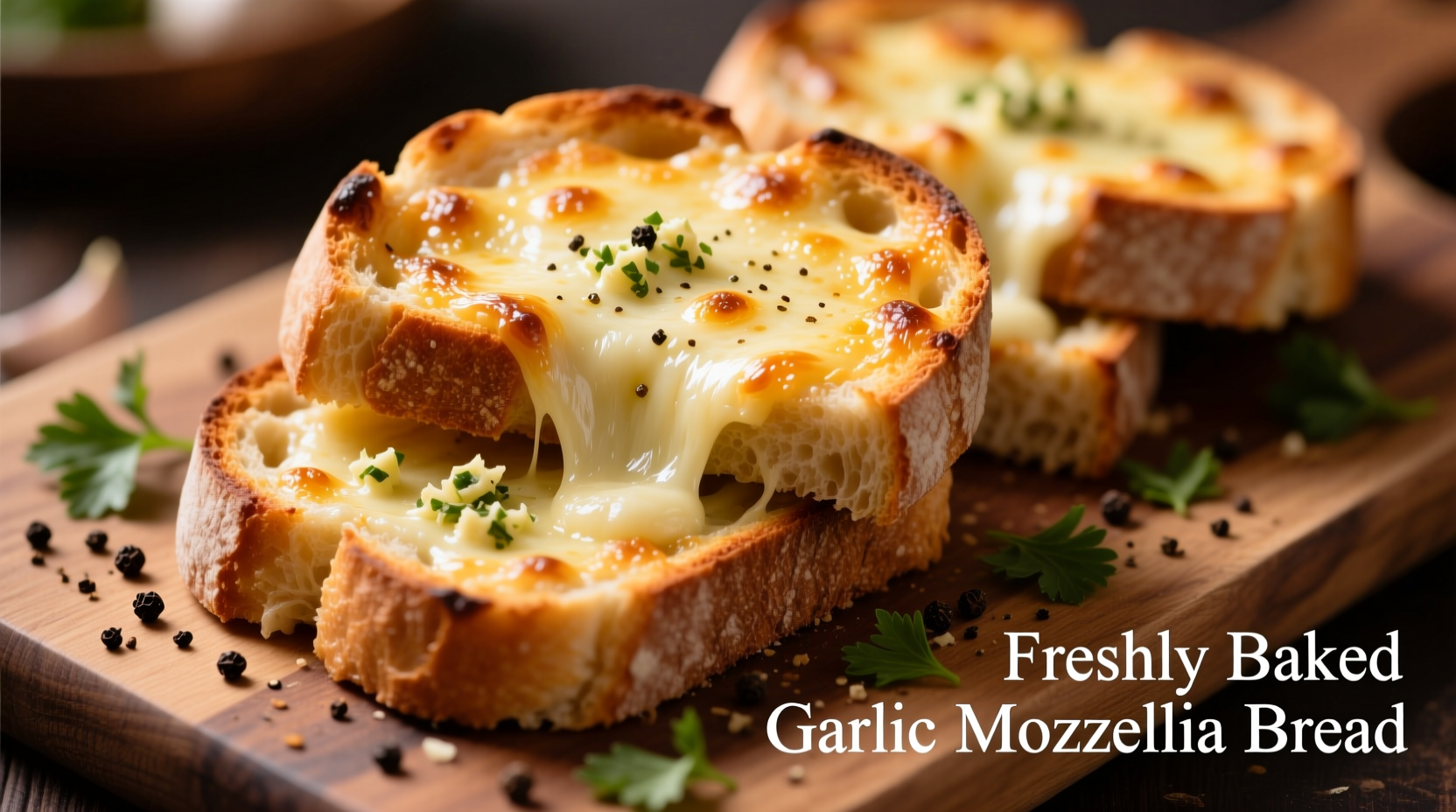Garlic mozzarella bread combines crispy bread, aromatic garlic, and perfectly melted mozzarella for an irresistible side dish or appetizer. This guide delivers a foolproof recipe with professional techniques for achieving golden crust, optimal cheese melt, and balanced garlic flavor every time—no soggy bread or burnt edges.
There's nothing quite like the aroma of freshly baked garlic mozzarella bread filling your kitchen. Unlike traditional garlic bread that relies on harder cheeses, this version features the creamy, stretchy goodness of mozzarella that creates an addictive texture contrast between the crispy exterior and molten interior. Whether you're preparing a quick weeknight side or impressing guests at a dinner party, mastering this simple yet sophisticated bread requires understanding the science behind each ingredient and technique.
Why Mozzarella Makes All the Difference
While classic garlic bread typically uses parmesan or a parmesan-romano blend, swapping in mozzarella transforms the experience. Mozzarella's unique protein structure and higher moisture content (approximately 50-60% compared to parmesan's 30%) creates that signature stretch and creamy melt that harder cheeses can't replicate. Food scientists at the University of Wisconsin's Center for Dairy Research confirm that low-moisture mozzarella melts at 130°F (54°C), making it ideal for baking applications where complete melting is desired without separation.
| Cheese Type | Melting Point | Moisture Content | Best For Garlic Bread |
|---|---|---|---|
| Low-moisture Mozzarella | 130°F (54°C) | 45-52% | ★★★★★ Perfect melt, stretchy texture |
| Fresh Mozzarella | 140°F (60°C) | 55-60% | ★★★☆☆ Can make bread soggy |
| Parmesan | 162°F (72°C) | 28-34% | ★★☆☆☆ Adds flavor but doesn't melt well |
| Provolone | 135°F (57°C) | 40-45% | ★★★★☆ Good melt with sharper flavor |
The Evolution of Garlic Bread: From Italian Roots to Mozzarella Innovation
Garlic bread's journey began as "pane all'aglio" in rural Italy, where peasants rubbed stale bread with raw garlic and olive oil to revive it. The American version emerged in Italian-American restaurants during the 1940s, initially featuring butter and garlic only. Cheese entered the equation in the 1970s as Italian-American chefs experimented with parmesan. The mozzarella variation gained popularity in the 1990s when pizzerias began offering it as a complementary side, capitalizing on the cheese's perfect melting properties that pair exceptionally well with tomato-based dishes.
Essential Ingredients and Why They Matter
Bread Selection Guide
The foundation of exceptional garlic mozzarella bread starts with the right bread. Artisan baguettes or ciabatta provide the ideal structure—crisp exterior with open, airy interior that absorbs flavors without becoming soggy. Avoid pre-sliced sandwich bread, which lacks the necessary structure. According to the Bread Bakers Guild of America, bread with 65-70% hydration works best for this application, providing sufficient chew without excessive moisture.
Garlic Preparation Techniques
Raw garlic delivers pungent heat that can overwhelm other flavors, while roasted garlic offers sweet, mellow complexity. For balanced flavor, combine both: roast half your garlic cloves at 375°F (190°C) for 20 minutes while using the other half raw. The USDA's Food Safety and Inspection Service recommends never storing garlic in oil at room temperature due to botulism risk, so always prepare your garlic butter mixture fresh or refrigerate immediately.

Step-by-Step Preparation Guide
Creating the Perfect Garlic Butter
- Combine ½ cup unsalted butter (softened) with 4 minced roasted garlic cloves and 2 minced raw garlic cloves
- Add 2 tablespoons fresh parsley, 1 teaspoon dried oregano, and ½ teaspoon red pepper flakes
- Mix thoroughly but avoid overworking, which can make the butter greasy
Bread Preparation and Assembly
- Preheat oven to 375°F (190°C) with rack in center position
- Cut baguette diagonally into 1-inch slices, leaving bottom intact for presentation
- Spread garlic butter mixture between slices, ensuring even coverage
- Generously sprinkle 1½ cups shredded low-moisture mozzarella between slices
- Wrap loosely in foil for initial baking (15 minutes) to melt cheese evenly
- Remove foil and bake additional 8-10 minutes until golden and crispy
Pro Tips for Restaurant-Quality Results
- Avoid soggy bread: Brush bread with a thin layer of plain butter before adding garlic mixture to create a moisture barrier
- Perfect cheese melt: Toss shredded mozzarella with 1 tablespoon cornstarch to prevent separation during baking
- Garlic intensity control: Soak minced garlic in lemon juice for 10 minutes before mixing to mellow raw bite
- Crispiness secret: Finish under broiler for 1-2 minutes, watching carefully to prevent burning
When to Serve Garlic Mozzarella Bread: Context Matters
While delicious any time, garlic mozzarella bread shines in specific contexts. Food anthropologists note that cheese-focused garlic bread pairs exceptionally well with tomato-based dishes because the acidity cuts through the richness. It's ideal for:
- Pasta nights (especially with marinara or arrabbiata sauces)
- Pizza gatherings as a complementary side
- Casual dinner parties where interactive, shareable food is preferred
- Cold weather months when comforting, warm bread is especially welcome
Avoid serving with delicate seafood dishes or light salads where the strong garlic flavor would dominate.
Troubleshooting Common Problems
Under-Melted Cheese
If your cheese isn't melting properly, your oven temperature may be too low or you might be using fresh mozzarella with excessive moisture. Switch to low-moisture mozzarella and ensure your oven is properly calibrated. The National Institute of Standards and Technology recommends using an independent oven thermometer for accuracy, as built-in thermostats can be off by 25°F or more.
Burnt Garlic
Raw garlic burns easily at standard baking temperatures. To prevent this, always combine raw and roasted garlic, and consider adding half your garlic mixture after the initial foil-wrapped baking phase. The Maillard reaction that creates desirable browning occurs between 280-330°F (135-165°C)—exceeding this range causes burning.
Creative Variations to Try
- Mediterranean twist: Add sun-dried tomatoes and kalamata olives between slices
- Spicy arrabbiata style: Mix in 2 tablespoons arrabbiata sauce with the garlic butter
- Four-cheese delight: Combine mozzarella with provolone, fontina, and a small amount of parmesan
- Breakfast version: Add a beaten egg mixture between slices for a savory bread pudding effect
Serving and Storage Recommendations
For optimal texture, serve garlic mozzarella bread immediately after baking. The ideal serving temperature is 140-160°F (60-71°C), when the cheese maintains its stretchy quality without being scalding hot. Leftovers should be stored in an airtight container at room temperature for up to 24 hours or refrigerated for up to 3 days. To reheat, wrap in foil and warm at 325°F (163°C) for 10-15 minutes, then finish under the broiler for 1-2 minutes to restore crispness. The FDA Food Code specifies that cooked bread products should not be held between 41°F and 135°F (5°C and 57°C) for more than 4 hours to prevent bacterial growth.











 浙公网安备
33010002000092号
浙公网安备
33010002000092号 浙B2-20120091-4
浙B2-20120091-4